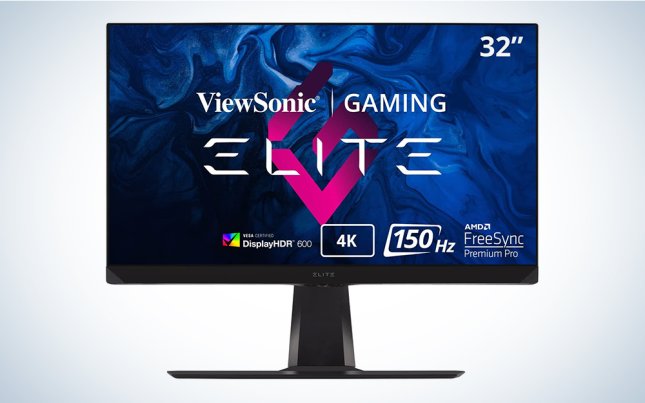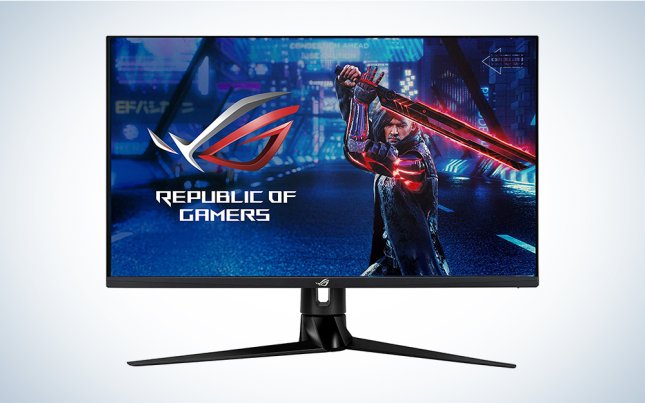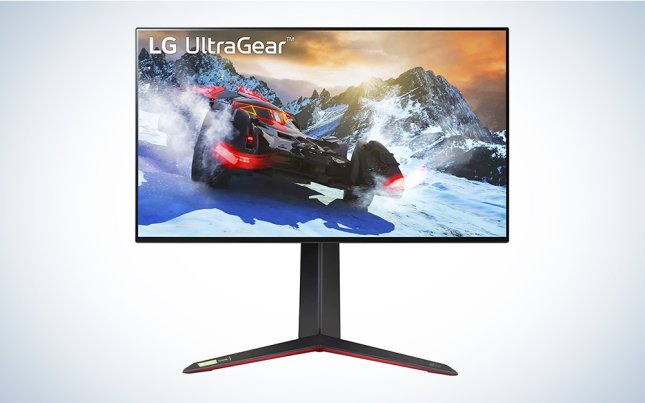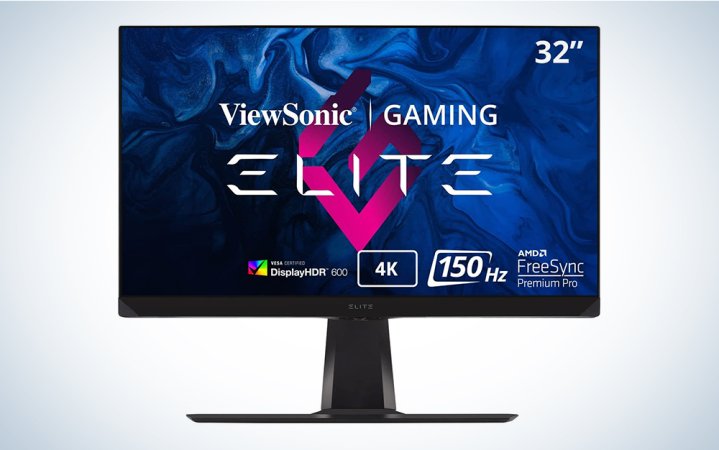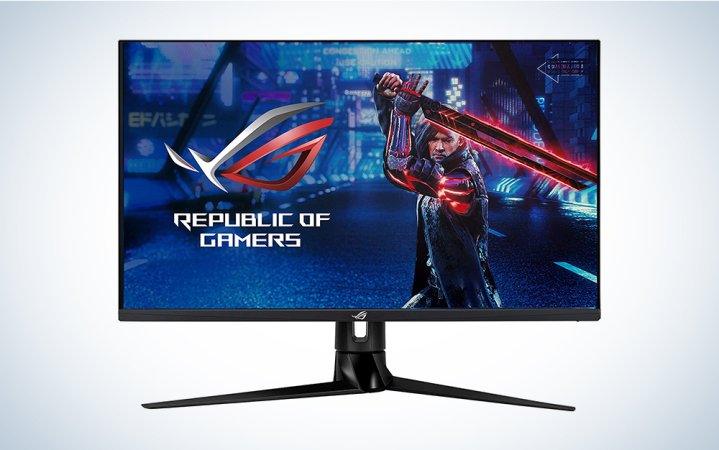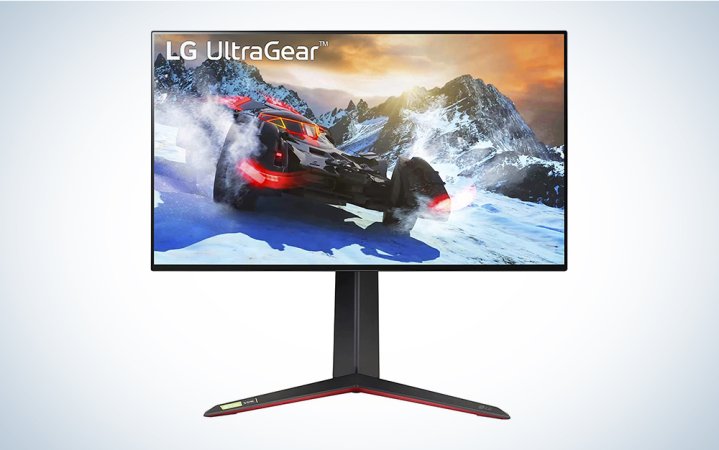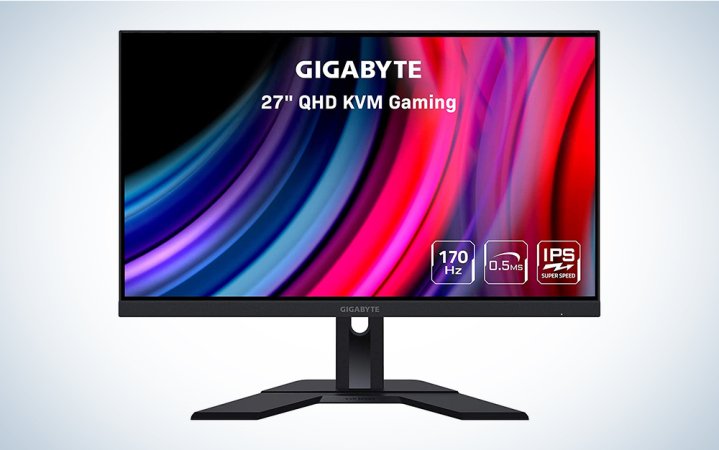We may earn revenue from the products available on this page and participate in affiliate programs. Learn more ›

With the proper hardware, PC gaming unlocks a thrilling world of possibilities you can’t get anywhere else. Nothing can ruin that excitement faster than technical hangups like stuttering and screen tearing. Luckily, modern gaming PCs and monitors now support variable refresh rate features like AMD FreeSync, which prevent those issues and provide players with smoother, more fluid animations. FreeSync and its counterpart, Nvidia G-Sync, are display technologies, so you need to keep an eye out for which one you want to use when picking out a new gaming monitor. We’ll help you learn the ropes of FreeSync, and help you pick the best FreeSync monitor for your gaming rig.
- Best overall: ViewSonic ELITE XG320U
- Best 1440p: Asus ROG Swift PG329Q
- Best 4K: LG UltraGear 27GP950-B
- Best FreeSync Premium Pro: Samsung Odyssey G7
- Best ultrawide: LG 34GP83A-B UltraGear Gaming Monitor
- Best budget: Gigabyte M27Q
What is AMD FreeSync?
AMD FreeSync is one of two versions of adaptive sync technology, also known as variable refresh rate. Introduced by graphics card manufacturer AMD in 2015, FreeSync mitigates “visual artifacts,” or flaws in your monitor’s image like stuttering and screen tearing. By matching your monitor’s target refresh rate with the maximum output set by your FreeSync-compatible GPU, your system avoids falling out of step when your PC’s performance momentarily rises or dips.
FreeSync is one of two technologies providing this feature, but it is the more common of the two. The other version, Nvidia G-Sync, technically calls for a proprietary chip in the monitor hardware and is specifically designed for Nvidia GPUs. FreeSync, on the other hand, is purely software-based, which makes it more affordable for manufacturers. As such, FreeSync support is more common than G-Sync, especially in less expensive displays. That said, both connections are widely available in today’s monitors.
There are currently three tiers of FreeSync support. The basic version of FreeSync offers lower latency and a tear-free experience. The middle tier, FreeSync Premium, supports lower latency for 1080p monitors with a 120Hz refresh rate or higher. It also adds “low framerate compensation,” which allows FreeSync to continue working when the frame rate dips below the minimum refresh rate of the display. The top tier, FreeSync Premium Pro, features everything in Premium and adds high dynamic range (HDR) support for improved visual fidelity when playing games and watching videos.
How we picked the best FreeSync monitors
I have over ten years of experience reviewing consumer electronics for websites like TechnoBuffalo, XDA Developers, and Gear Patrol. I’ve built gaming PCs and have used various monitors for testing purposes, evaluating important metrics like display quality, connectivity, and color accuracy. When I’m not assessing monitors for a review, I’m using one to watch movies, play video games, and edit photos. When selecting these displays, I drew on my prior testing experience and knowledge, as well as critical consensus from professional reviewers, consumer feedback, and forum chatter on the intricacies of the most popular gaming monitors.
The best FreeSync monitors: Reviews & Recommendations
FreeSync is a widely adopted format. It isn’t hard to find monitors that support it. Of course, the more options there are, the harder it is to find the best FreeSync monitors. These are currently our top picks.
Best overall: ViewSonic Elite XG320U
Best overall
FreeSync Champ
Buy it used or refurbished: eBay
Why it made the cut: The ViewSonic Elite XG320U has a sharp 4K display, plenty of ports, and a FreeSync Premium Pro rating.
Specs
- Screen size: 32-inch
- Resolution: 3840 x 2160 pixels (4K)
- Refresh rate: 150Hz
- Ports: HDMI 2.0, HDMI 2.1, DisplayPort 1.2, USB-A 3.1 x 3, USB-B 3.1, Micro-USB
- Panel type: IPS
- HDR: VESA DisplayHDR 600
- FreeSync: FreeSync Premium Pro
Pros
- Excellent 4K picture
- FreeSync Premium Pro
- HDMI 2.1
Cons
- Expensive
The ViewSonic Elite X320U features an impressive 32-inch 4K panel, and support for Freesync Premium Pro, opening the door for excellent HDR performance and a bright, vivid picture. It also offers a snappy 1ms response time. Additionally, the ViewSonic Elite X320U features an excellent array of ports, including HDMI 2.1, making it a great pick for consoles and PCs.
Best 1440p: Asus ROG Swift PG329Q
Best 1440p
QHD Excellence
Buy it used or refurbished: eBay
Why it made the cut: The Asus ROG PG329Q features a sharp 1440p display, 175Hz refresh rate, and DisplayHDR 600.
Specs
- Screen size: 32-inch
- Resolution: 2560 x 1440 pixels
- Refresh rate: 175Hz
- Ports: HDMI 2.0 x 2, DisplayPort 1.2, USB-A 3.0 x 2, USB-B 3.0
- Panel type: IPS
- HDR: VESA DisplayHDR 600
- FreeSync: FreeSync
Pros
- Fast response time
- DisplayHDR 600
- Bright, vibrant display
Cons
- Limited contrast ratio
If you’re upgrading from 1080p to 1440p, the Asus ROG Swift PG329Q offers an excellent way to step up your visuals. It features a sharp, vibrant IPS panel that covers 98 percent of the DCI-P3 color gamut. At the same time, it keeps your games looking smooth with a 175Hz refresh rate and 1ms response time. It only offers standard FreeSync, so you’ll have to choose between variable refresh rate and HDR, but having VESA DisplayHDR 600 rating means you actually have options.
Best 4K: LG UltraGear 27GP950-B
Best 4K
Free to Sync in 4K
Buy it used or refurbished: eBay
Why it made the cut: The UltraGear 27GP950-B is one of LG’s best monitors, and it just happens to support FreeSync Premium Pro.
Specs
- Screen size: 27-inch
- Resolution: 3840 x 2160 pixels (4K)
- Refresh rate: 144Hz
- Ports: HDMI 2.1 x 2, DisplayPort 1.4, USB-A 3.2 Gen 1 x 2, USB-B
- Panel type: IPS
- HDR: VESA DisplayHDR 600
- FreeSync: FreeSync Premium Pro
Pros
- Excellent 4K display
- DisplayHDR 600
- HDMI 2.1
Cons
- Limited contrast
The LG UltraGear 27GP950-B is one of our favorite monitors from LG, and it’s easy to see why. It features a gorgeous 27-inch 4K display that supports a smooth 144Hz refresh rate. The IPS panel covers 98 percent of the DCI-P3 color space, and DisplayHDR 600, so it can achieve high levels of brightness. With FreeSync Premium Pro support, that means you get variable refresh rate and HDR working together. It almost brings a tear to your eye …
Best FreeSync Premium Pro: Samsung Odyssey G7
Best FreeSync Premium Pro
Premium and Pro
Buy it used or refurbished: eBay
Why it made the cut: Samsung’s curved Odyssey G7 display brings all the trappings of a luxury monitor, including 1440p resolution, QLED brightness, a 240Hz refresh rate, and FreeSync Premium Pro.
Specs
- Screen Size: 27-inch (32-inch also available)
- Resolution: 2560 x 1440
- Refresh rate: 240Hz
- Ports: HDMI 2.0, DisplayPort 1.4, 2 x USB-A 3.0
- Panel type: VA
- HDR: VESA DisplayHDR 600
- FreeSync: FreeSync Premium Pro
Pros
- Rich, vibrant display
- VESA DisplayHDR 600
- 240Hz refresh rate
Cons
- Narrow viewing angles
The Samsung Odyssey G7 comes in 27- and 32-inch variants, both of which look incredibly sharp. The deeply curved 4K display creates an intense sense of immersion, spreading your games to reach the corners of your peripheral vision. Vivid colors and deep blacks feel bolder and brighter thanks to a 1440p VA panel and QLED-enhanced DisplayHDR 600 brightness. Curved displays are an acquired taste, but this monitor may just convert you.
Best ultrawide: LG 34GP83A-B UltraGear Gaming Monitor
Best ultrawide
Wide Viewing
Buy it used or refurbished: eBay
Why it made the cut: Featuring a 34-inch curved 21:9 display, 144Hz refresh rate, and support for FreeSync Premium, the LG 34GP83A-B is a great ultrawide monitor.
Specs
- Screen size: 34-inch
- Resolution: 3440 x 1440 pixels (21:9)
- Refresh rate: 144Hz
- Ports: HDMI 2.0 x 2, DisplayPort 1.4, USB-A 3.0 x 2, USB-B 3.0
- Panel type: IPS
- HDR: VESA DisplayHDR 400
- FreeSync: FreeSync Premium
Pros
- Wide, vibrant display
- FreeSync Premium support
- Low input lag
Cons
- Low contrast
Once you start using a curved display, it’ll only be a matter of time until you start to consider the merits of a 21:9 curved ultrawide monitor, which extends that immersive wrapping screen to give as much space as two small monitors combined. The LG UltraGear 34GP83A-B is a great gateway into that specific, wider view, with a 34-inch, 3440 x 1440 pixel display with a 144Hz refresh rate, and support for FreeSync Premium. That means you get low latency and support for low framerate compensation, which allows FreeSync to continue working when the framerate dips below the minimum refresh rate of the display.
Again, ultrawide displays aren’t for everyone; It takes a little more futzing with settings to get games looking perfect. The people who like them swear by them, though, so it’s always an interesting choice to keep in mind.
Best budget: Gigabyte M27Q
Best budget
An Easy Upgrade
Buy it used or refurbished: eBay
Why it made the cut: With a 27-inch QHD display and FreeSync Premium support, the Gigabyte M27Q gives you strong specs at an affordable price.
Specs
- Screen size: 27-inch
- Resolution: 2560 x 1440 pixels
- Refresh rate: 144Hz
- Ports: HDMI 2.0 x 2, DisplayPort 1.2, USB-A 3.0 x 2, USB-B 3.0, USB-C 3.0
- Panel type: IPS
- HDR: VESA DisplayHDR 400
- FreeSync: FreeSync Premium
Pros
- Excellent Quad HD picture
- Fantastic response time
- Affordable
Cons
- Poor black levels
If you want FreeSync Premium at a comparatively affordable price, the Gigabyte M27Q is a very solid, budget-conscious upgrade pick. This 27-inch 1440p display features a 144Hz refresh rate and low 1ms response time. It also features 92 percent coverage of DCI-P3 wide color gamut, which is a very solid showing at this price. At 360Hz, I wouldn’t exactly call the M27Q “cheap,” per se, but there are plenty of similar monitors with higher price tags.
What to look for when choosing the best FreeSync monitors
At this point, most gaming monitors support FreeSync. Aside from avoiding G-Sync monitors to save some money, picking a FreeSync monitor is essentially the same as picking any other gaming monitor. That means you’ll want to consider all the core elements of any display, including screen size, resolution, frame rate, and connectivity. We get it—picking monitors is a pain. Hopefully, this will help make sense of things as you shop.
Resolution and size
Screen resolution refers to the number of pixels your monitor uses to create an image, which determines how crisp and detailed an image looks. Most modern monitors feature one of three display sizes: The baseline is 1920 x 1080, or 1080p for short. There’s a middle option, 2560 x 1440 pixels, which manufacturers call 1440p or Quad HD. At the top, you have 3840 x2160, or 4K UHD. You will see variations on these resolutions, particularly among ultrawide gaming monitors, but most target one of these three.
1080p, also called Full HD, is the current standard for most basic monitors, whether they’re made for gaming or for general use. While more and more gaming PCs are capable of playing games in 1440p and 4K, 1080p remains the most affordable option and the easiest way to ensure your game runs smoothly. If you own a PC with older components, choosing a 1080p monitor will allow you to maintain a higher framerate.
1440p is a great option if you own a mid-range or high-end PC. It offers a sharp, detailed picture for players who want the highest possible visual fidelity without sacrificing technical performance. Unlike with TVs and console gaming, running games in 4K is a luxury reserved for high-end graphics cards. We primarily recommend 4K displays for creative professionals, such as photographers and video editors.
Screen size also impacts image quality. Most displays come in 24, 27, or 32 inches, all of which provide plenty of screen real estate if you’re sitting between 1 foot and 3 feet away. Of course, you can go bigger or smaller depending on your needs and the size of your workspace, and you should scale your desired resolution with the screen size that works best for you.
When picking your display, keep in mind that size and resolution can complement each other. A 24-inch 4K display and a 32-inch 4K display both show the same number of pixels, but spread them across different areas. While you might expect bigger size and higher resolution are always better, we find that the most important thing is balance. A 24-inch display will have more pixels per inch, but some text and icons may be difficult to see because they’re so small.
We’d recommend sticking with 1080p if you’re looking at a 24-inch monitor, or a 27-inch 1440p monitor. If you’re looking for a big monitor—32 inches or larger—you’ll want to spend the extra money for 4K. These are recommendations, not hard rules. There are great 27-inch 4K monitors and 32-inch Quad HD monitors, so don’t worry if money or other specs lead you to another combination.
Refresh rate
Refresh rate, measured in Hertz (Hz), refers to the number of times your display updates each second. The higher the refresh rate, the smoother and more fluid animations will look. Though it can impact how your mouse moves around your desktop, having a high refresh rate disproportionately impacts gaming performance. Your monitor’s maximum refresh rate sets a game’s maximum framerate.
Most home and office monitors stick to a basic 60Hz framerate. We generally recommend PC gamers purchase a monitor with a 144Hz refresh rate or higher. Competitive players who spend their time with shooters, MOBAs, and other esports may want to aim for a higher refresh rate: There are plenty of 240Hz monitors and high-end models that go up to 360Hz. By the end of 2023, you should be able to buy a 500Hz gaming monitor.
Your monitor sets the upper and lower limits for what you can see, but your PC actually runs the game, so it determines what frame rates are possible for any given game. The more powerful your PC, the higher your frame rate will go. On PC, you also often have the option to turn down visual settings, reducing fidelity to allow for higher frame rates and smoother performance.
Connectivity
FreeSync operates over DisplayPort and HDMI, both of the audio/visual standards available in just about every PC monitor available today. Having access to both gives you a lot of flexibility when setting up your gaming PC.
You’re probably familiar with HDMI, or High-Definition Multimedia Interface. Introduced in 2002, it’s the most common A/V connection found in TVs, soundbars, and, yes, monitors. The current version of the standard, HDMI 2.1, is increasingly important in TVs and monitors for playing PS5 and Xbox Series X games. The previous version, HDMI 2.0, is still dominant among modern monitors, though, and perfectly fine unless you plan to play games in 4K above 60Hz. (For more about the nuances of HDMI, check out our explainer on HDMI 2.1 and then pick up the best HDMI cables.)
Realistically, though, DisplayPort is the connection of choice for PCs and monitors. As with HDMI, you’ll encounter multiple versions of the standard—including 1.2, 1.3, 1.4, and 2.0—each with its own benefits and restrictions. We recommend looking for monitors that support DisplayPort 1.4 (and above), which ensures support for up to 8K video with HDR at 60Hz. Most players will get their desired frame rate and resolution from DisplayPort 1.3, which supports up to 4K at 120Hz or 8K at 30Hz, but it doesn’t support HDR.
High dynamic range (HDR)
High dynamic range, commonly known as HDR, is a display technology that empowers a monitor to show varying brightness levels on different parts of a screen. It is most frequently referenced as a gaming feature, though some streaming services offer HDR-enhanced content.
HDR has become ubiquitous in TVs but is considered a luxury feature in gaming monitors. This is, in large part, because monitors must be very bright to support properly show the wide variations in brightness HDR offers. If you want to use HDR, we generally recommend looking for a monitor with a VESA DisplayHDR 600 rating or higher, or a monitor with a maximum brightness of at least 600 nits.
HDR gets even more complicated when you try to use it and FreeSync at the same time. Currently, you can only use them both on monitors that support FreeSync Premium Pro. Moreover, FreeSync Premium Pro’s HDR differs slightly from a conventional HDR pipeline. According to AMD, a monitor that supports FreeSync Premium Pro passes specifications and data straight to a PC, allowing games to directly tone map to the display. This helps reduce input latency. FreeSync Premium Pro’s baseline HDR requires display support DisplayHDR 400 or higher, resulting in at least twice the perceived color volume as SDR (sRGB).
Panel type
The majority of today’s monitors, with few exceptions, feature LED-backlit liquid crystal displays. The screen panels themselves come in three different varieties, which feature characteristics that will impact your monitor’s performance. Our picks focus on two of the three: Vertical alignment (VA) and in-plane switching (IPS). The third type, twisted nematic (TN), is often found in monitors that prioritize response time over color accuracy and depth.
IPS panels offer excellent color reproduction but struggle with poor contrast. This should lead to bold colors, but you may not get the sharpest lines and deepest blacks. VA panels offer impressive contrast and color reproduction, but trend toward higher response times, so they’re more prone to motion blur and ghosting. Ultimately, these distinctions are relatively minor—there are fast VA panels and sharp-looking IPS displays. However, it is useful as a shorthand if you want to avoid diving into reviews and forum posts about color accuracy.
FAQs
FreeSync’s minimum requirements aren’t as stringent as Nvidia G-Sync. FreeSync is a software-based solution and only requires an AMD GPU and a compatible monitor or TV.
More specifically, FreeSync works with all AMD Radeon graphics cards, beginning with Radeon RX 200 Series, and Radeon consumer graphics products that use GCN 2.0 architecture or later. Compatible desktop APUs include Ryzen APUs with a motherboard DisplayPort or HDMI connections. According to AMD, there are now over 950 monitors and over 50 TVs that support FreeSync technology.
It’s also worth pointing out that Nvidia GPUs should also support FreeSync in many cases when plugged in via DisplayPort. Check Nvidia’s list of G-Sync compatible monitors for more information.
Yes and no. Technically variable refresh rate can improve visual conditions outside of games, particularly in programs that require a lot of computing power. Practically speaking, however, FreeSync is designed to improve the visual fidelity of games. If you aren’t planning on playing many or any games, FreeSync is a nice value add, but you don’t need to worry about it when picking your next monitor.
The differences between G-Sync and FreeSync are relatively small. Conventional G-Sync requires manufacturers to build a dedicated chip into the monitor. That conveys some benefits, including lower input lag, a broader variable refresh rate (VRR), and variable overdrive. G-Sync monitors also have a slightly wider refresh rate window, allowing it to stabilize lower framerates.
That said, FreeSync is cheaper for manufacturers to add and support because it doesn’t require a chip. That means there are more FreeSync monitors out there than G-Sync, including many cheap gaming monitors. However, that gap is closing thanks to Nvidia’s hardware-free “G-Sync Compatible” designation.
Final thoughts on the best FreeSync monitors
- Best overall: ViewSonic ELITE XG320U
- Best 1440p: Asus ROG Swift PG329Q
- Best 4K: LG UltraGear 27GP950-B
- Best FreeSync Premium Pro: Samsung Odyssey G7
- Best ultrawide: LG 34GP83A-B UltraGear Gaming Monitor
- Best budget: Gigabyte M27Q
If you’re looking to get the most out of every game you play, FreeSync can help keep your games stable and looking their best. Whether you’re playing visually demanding games like God of War or Forza Horizon 5, it can eliminate graphical imperfections like stutter, lag, and tearing for smooth, fluid animations. If you’re using a gaming PC with an AMD GPU, you should definitely make sure your monitors support FreeSync.
